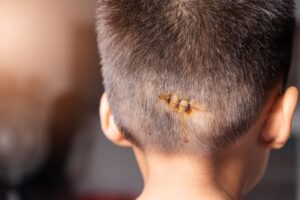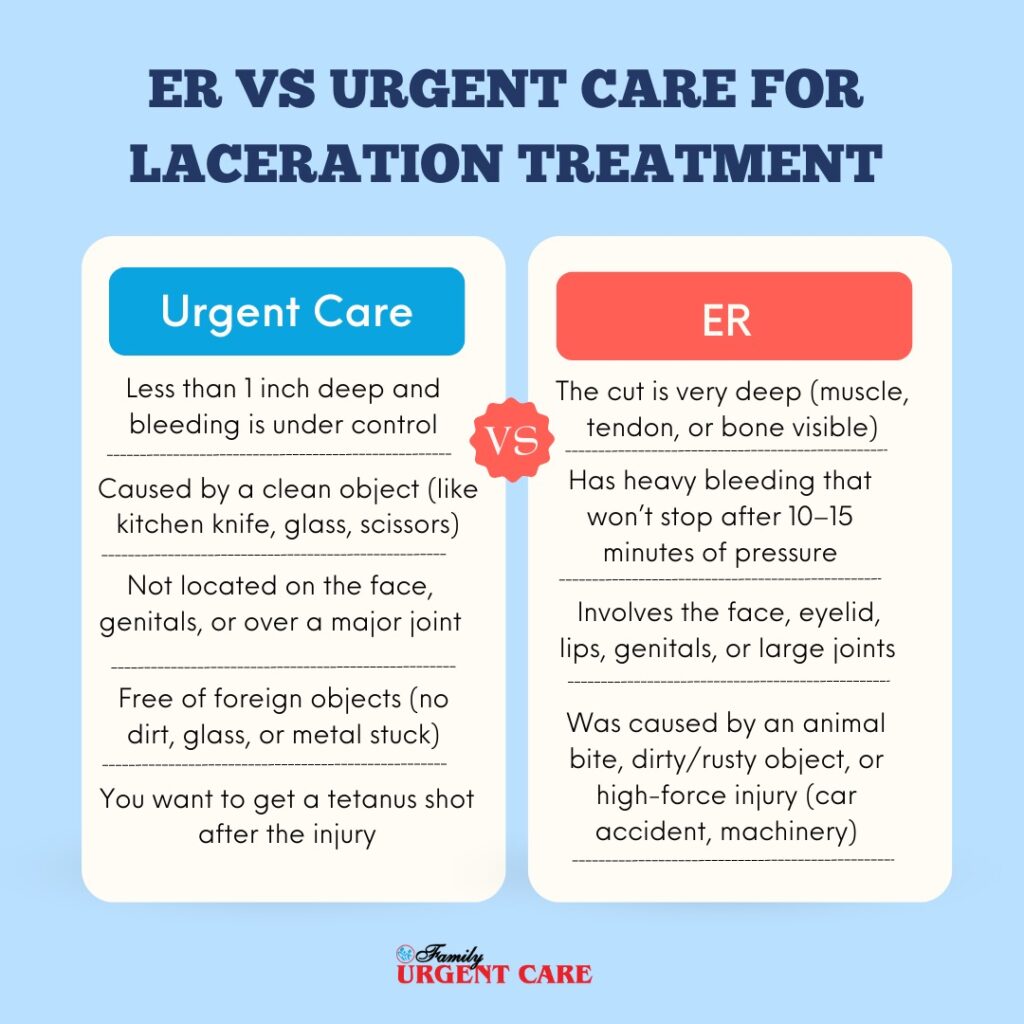Same day Laceration or Cuts Repair At Family Urgent Care
A laceration is a type of wound that has a torn or irregular edge and is caused by forceful impact, blunt trauma, or a sharp object that tears the tissues.
Depending on the cause, a laceration can vary in depth and severity. For instance, lacerations occur due to accidents, falls, or contact with sharp objects such as knives, glass pieces, or other tools.
Whether you have a cut or a laceration, you might need proper wound care and handling to minimize the risk of potential infections. Therefore, seeking medical help for laceration repair at an urgent care clinic is a better option, as trained medical professionals take all the measures to prevent infections and make sure that the wound heals properly and doesn’t give you a scar.
So, visit Family Urgent Care by booking an appointment or directly walking in to receive prompt care and safe handling of lacerations or cuts!
When Should You Visit An Urgent Care For Laceration Repair?
If your cut or wound is not bleeding or is small and clean, then you do not need to visit an urgent care facility for professional medical care. You can clean your wound with an antiseptic, apply an antibiotic ointment, and cover it with a sterile gauze or an adhesive bandage.
However, your laceration or cut might need professional medical attention at an urgent care in the following scenarios:

- If there is debris, dirt, or any other foreign object, even after cleaning your wound
- If the location of the wound is on the face, joints, chest, or genitals, you might need help from experienced healthcare professionals.
- You can see exposed tissue with some bleeding that’s not life-threatening
- The wound has jagged or uneven edges, or there’s a high risk of scarring or infection.
What Are The Treatment Options For Lacerations or Cuts?
At Family Urgent Care, we have trained medical staff and the right tools and supplies to provide appropriate care for your wound. Here’s how we can help you in repairing your wound:
- Proper Wound Cleaning: The provider thoroughly cleans the wound with normal saline or antiseptic to prevent infection.
- Tissue Adhesion: The healthcare provider uses a special glue or adhesive to hold the wound together, reducing the risk of infection or further injury.
- Adhesive Strips: (Steri strips): We might use adhesive strips to close the wound, depending on the type of wound you have. The strips can be removed after a week or they might fall off on their own.
- Suturing: If your wound is deep and bleeding, the provider might apply stitches to close it and cover it with gauze.
- Stapling: If the laceration is on the scalp, neck, arms, buttocks or legs, placing staples to close the wound might be a better option.
- Tetanus Shots: The provider might give you a tetanus shot if needed.
- At-Home Care: You received counseling from the provider about cleaning the wound or changing the dressings at home. The provider might also ask you to monitor the signs of infection.
The choice of treatment depends on factors such as the nature, size, and location of the laceration, the patient’s medical history, and the healthcare provider’s assessment of the wound.
So, do not wait and visit the Family Urgent Care clinic for non-life-threatening cuts or lacerations for
prompt treatment and care. Book your appointment now!
When to Go to Urgent Care vs. the ER for Lacerations and Cuts?

FAQs
At urgent care, providers start by cleaning the wound to prevent infection. Depending on the depth and location of the cut, they may use:
- Stitches (sutures) for deeper cuts
- Skin glue or adhesive strips for smaller, clean cuts
- Tetanus shots or antibiotics if needed
At Family Urgent Care, we also give aftercare instructions and schedule follow-ups to ensure proper healing.
No appointment is needed. At Family Urgent Care, we accept walk-ins for bug bite evaluations at all our locations. Just come in if you’re experiencing swelling, pain, redness, or an allergic reaction.
Most insurance plans cover treatment for bug bites, especially if there’s an allergic reaction, infection, or swelling that requires medical care. We accept most major insurance providers at Family Urgent Care. You can call us to confirm your coverage.
Yes, Benadryl (diphenhydramine) is an over-the-counter antihistamine that can help reduce itching, swelling, and allergic reactions from bug bites. However, if symptoms persist or worsen, it's best to visit a clinic for proper care.
Neosporin can help prevent infection if a bug bite is open, scratched, or irritated. But it doesn’t reduce itching or swelling. If there are signs of infection (pus, redness, pain), it is better to visit a provider for treatment.
Yes, calamine lotion can soothe itching and irritation caused by bug bites. It's often used for mosquito or chigger bites. If the bite gets worse or you're unsure what caused it, we recommend seeing a healthcare provider.



